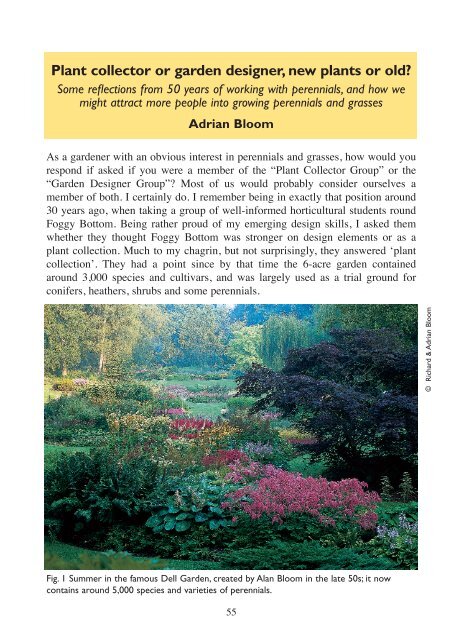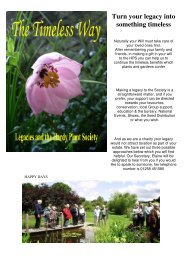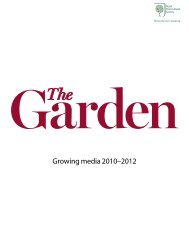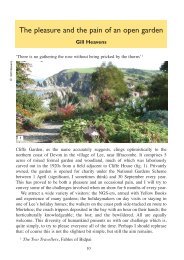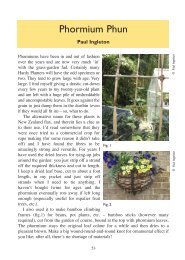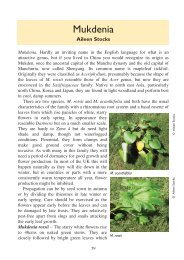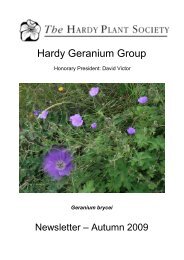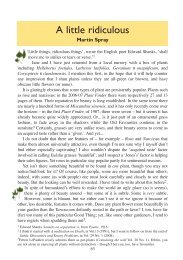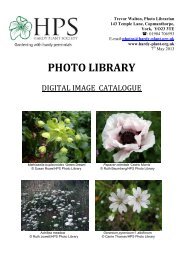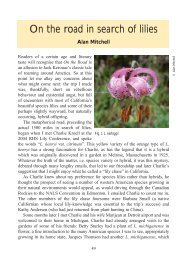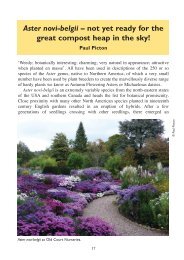012 adrian bloom - Hardy Plant Society
012 adrian bloom - Hardy Plant Society
012 adrian bloom - Hardy Plant Society
You also want an ePaper? Increase the reach of your titles
YUMPU automatically turns print PDFs into web optimized ePapers that Google loves.
<strong>Plant</strong> collector or garden designer, new plants or old?<br />
Some reflections from 50 years of working with perennials, and how we<br />
might attract more people into growing perennials and grasses<br />
Adrian Bloom<br />
As a gardener with an obvious interest in perennials and grasses, how would you<br />
respond if asked if you were a member of the “<strong>Plant</strong> Collector Group” or the<br />
“Garden Designer Group”? Most of us would probably consider ourselves a<br />
member of both. I certainly do. I remember being in exactly that position around<br />
30 years ago, when taking a group of well-informed horticultural students round<br />
Foggy Bottom. Being rather proud of my emerging design skills, I asked them<br />
whether they thought Foggy Bottom was stronger on design elements or as a<br />
plant collection. Much to my chagrin, but not surprisingly, they answered ‘plant<br />
collection’. They had a point since by that time the 6-acre garden contained<br />
around 3,000 species and cultivars, and was largely used as a trial ground for<br />
conifers, heathers, shrubs and some perennials.<br />
© Richard & Adrian Bloom<br />
Fig. 1 Summer in the famous Dell Garden, created by Alan Bloom in the late 50s; it now<br />
contains around 5,000 species and varieties of perennials.<br />
55
© Richard & Adrian Bloom<br />
Fig. 2 Brunnera macrophylla ‘Jack<br />
Frost’ has earned its place as one<br />
of the best perennials of all time.<br />
My 50 years of working with perennials began<br />
when, in 1958, I started working for our family<br />
business, Blooms Nurseries at Bressingham,<br />
helping to dig and plant in the unfinished Dell<br />
Garden. After four years abroad, working at<br />
nurseries in the USA, Switzerland and Denmark,<br />
I returned in 1962. By this time my father Alan<br />
Bloom had almost completed the 6-acre Dell<br />
Garden, stocked with a staggering collection of<br />
nearly 5,000 different species and cultivars of<br />
hardy perennials. Alan, through books and<br />
articles and early appearances on television’s<br />
Gardening Club with Percy Thrower, was doing<br />
his utmost to promote perennials. They had<br />
actually been in the doldrums for many years and<br />
in the 60s they were still seen as the Cinderellas<br />
of the horticulture industry, which is one reason<br />
that Alan, with a few like-minded people, started<br />
the <strong>Hardy</strong> <strong>Plant</strong> <strong>Society</strong> in 1957. The gardening<br />
public and public gardens were looking more for<br />
labour-saving shrubs and ground cover (and increasingly conifers and heathers).<br />
Also, perennials did not fit the fast-developing garden-centre market, which relied<br />
on container-grown plants – most perennials were still being grown and sold<br />
bare-root, or wrapped, and were therefore restricted to the traditional autumn and<br />
spring seasons.<br />
In the 60s and 70s the Blooms wholesale nursery, expanding into conifers,<br />
heathers and shrubs, developed rapidly, as did our retail mail order business under<br />
the Bressingham Gardens name. We were among the first to promote new plants,<br />
so it was perhaps indicative, yet ironic, that our biggest and most successful plant<br />
was a shrub, Potentilla fruticosa ‘Red Ace’, introduced with great fanfare at<br />
Chelsea in 1976: it projected us to a lead position in the new-plant market. By<br />
1980, conifers were half our business.<br />
Perennials and grasses, however, were not to be held back, and Blooms and<br />
Bressingham were primarily and rightly known for their perennial introductions<br />
and for holding one of the widest ranges available. What a resource the gardens<br />
offered as a gene bank! Although some new plants arose by chance, many more<br />
were bred by Alan Bloom and his canny helper, Percy Piper. When new plants<br />
were first introduced in the 50s there was less interest and promotion and it took a<br />
long time for them to be known, so the resurgence of perennials, through the<br />
demand for variety and colour, a wider awareness by the public, and more<br />
56
exposure from retail and garden centres,<br />
combined with media attention, allowed many<br />
a second coming. Many of Alan and<br />
Percy’s Bressingham selections have become<br />
classics and are still popular today; they include<br />
Achillea ‘Moonshine’ (1954), Agapanthus<br />
‘Bressingham Blue’ (1972), the diminutive Aster<br />
x frikartii ‘Flora’s Delight’ (1964), Astilbe<br />
‘Sprite’ (1969), Crocosmia ‘Lucifer’ (1966),<br />
Geranium (Cinereum Group) ‘Ballerina’ (1962),<br />
Helenium ‘Coppelia’ (1965), x Heucherella alba<br />
‘Bridget Bloom’ (1953), Kniphofia ‘Percy’s<br />
Pride’ (1975), Phlox paniculata ‘Franz Schubert’<br />
(1980) and many, many others. As nurserymen,<br />
retailers and gardeners we were lucky to be part<br />
of what now seems to be a golden age of<br />
horticulture, which was driven by rising<br />
prosperity, more leisure time and rapidly<br />
increasing home ownership. As many of us will<br />
remember, the growth of garden centres and<br />
specialist nurseries was phenomenal, and<br />
Fig. 3 On a frosty winter day<br />
Bergenia ‘Bressingham Ruby’ makes<br />
a colourful carpet beneath<br />
Chinochloa rubra.<br />
enthusiasm for plants utterly contagious. Perennials were no longer Cinderellas,<br />
but rather the belles of the ball. By the 80s perennials were in full fashion, more<br />
specialist nurseries sprang up to exhibit at Chelsea and other shows, and many<br />
larger wholesale tree and shrub nurseries moved into perennials too.<br />
The search for new plants of any sort began in earnest, and both the<br />
increasingly knowledgeable gardener and the media seemed to be clamouring for<br />
novel and interesting introductions. There was concern among plantspeople that,<br />
with so many new plants coming on to the market, older species and varieties<br />
would disappear, and so in 1978 the NCCPG (now <strong>Plant</strong> Heritage) was formed.<br />
The organisation and its members did and still do a great service, but it led to<br />
even more new cultivars being introduced by enthusiastic Collection holders.<br />
Wider travelling by nurserymen and the public, combined with easier<br />
international communications, allowed new plants to flow from country to<br />
country (subject to plant health restrictions) to add to the number of introductions<br />
each year.<br />
Rest assured that these historical snapshots are leading me to the theme of this<br />
article – one which I’ve been pondering over for a year or two. Have we, in the<br />
second decade of the millennium, now come to the point where there are too<br />
many new plants, and if so, could the horticultural industry inadvertently be<br />
© Richard & Adrian Bloom<br />
57
doing a disservice to the gardener, and particularly to the new gardener?<br />
First, some facts provided by scanning some issues of the <strong>Plant</strong> Finder, itself<br />
first issued in 1987 to log the species and varieties of plants on sale each year in<br />
Britain. In the first edition a total of 22,000 plants were listed, by 1992 55,000,<br />
and by 2009 over 70,000. Selecting specific genera amongst perennials and<br />
grasses shows amazing increases over the last 18 years. But how many new<br />
introductions are really different or garden worthy? In the 1992 <strong>Plant</strong> Finder<br />
there were 50 heucheras and by 2010, 208; pulmonarias went from 54 to 125;<br />
hellebores from 97 to 328; but the biggest increase was, you’ve guessed it, the<br />
popular and promiscuous hardy geraniums, rising from 255 to 724. Grasses made<br />
a later start but, selecting just two genera, pennisetums went from 9 in 1992/3 to<br />
45 in 2009/10; miscanthus from 37 to 121 in the same period.<br />
So even if you pity the poor Collection holder, shouldn’t we also pity the poor<br />
gardener who, faced with such a list of plants, can hardly know which is among<br />
the best and which to choose? Of course, the average garden centre, and even<br />
specialist nursery, is likely to have a much smaller selection, but how, unless you<br />
are immersed in the role of plantsman, can these businesses know which, say,<br />
heuchera, to recommend when several new ones are introduced each year? We all<br />
like to try out new plants, and some recent, wonderful, ground-breaking perennials<br />
© Richard & Adrian Bloom<br />
Fig. 4 This garden at the zu Jeddeloh nursery in northern Germany, designed by Adrian Bloom,<br />
shows how dramatic perennials and grasses can be. Blue Geranium Rozanne makes a perfect<br />
‘river’, while Miscanthus ‘Morning Light’, Crocosmia ‘Lucifer’ and other plants form the ‘banks’.<br />
58
have eventually stood out amongst the<br />
also-rans: perennials such as Geranium<br />
Rozanne, Brunnera macrophylla ‘Jack<br />
Frost’ and Sedum ‘Matrona’ come to<br />
mind. They have had time to prove<br />
themselves and remain reliably popular,<br />
but such continues to be the demand for<br />
new plants that competing nurseries are<br />
often compelled, it seems, to put on the<br />
market, often with considerable fanfare,<br />
plants which have not been fully trialled.<br />
Because of their promotional value they<br />
may well supplant the more worthy older<br />
plants on garden centre benches, leaving<br />
gullible and generally trusting gardeners<br />
to become the often disappointed and<br />
unsuccessful testers, frequently blaming<br />
themselves for any failure.<br />
Fig. 5 Actaea simplex Atropurpurea Group<br />
‘Brunette’ is highlighted by the spreading<br />
blue-flowered Geranium himalayense in spring.<br />
I may be painting an unduly pessimistic picture but, as a professional<br />
nurseryman and passionate gardener for so many years, I have seen it from both<br />
sides of the fence – and always with a desire to spread the word, to get more<br />
people gardening. It concerns me that many new gardeners, suffering early<br />
disappointment, may have been lost. I am assuming that members of the <strong>Society</strong><br />
are already motivated gardeners, and we all know how rewarding growing plants<br />
can be. Many of us remember the time when we had little knowledge and not<br />
much interest in plants and gardening, and then what a difference our gradual<br />
awareness made. Once fully motivated, most gardeners seldom look back, since<br />
we inhabit an exciting and changing world with lots of opportunities. Increasing<br />
knowledge of plants, their origins and habitats, their changing form and colour<br />
through the seasons of the year, the way they can associate with other plants and<br />
be used in creative ways, beauty of flower, foliage in close-up, fragrance, their<br />
capacity for being enhanced by frost, wind and above all, light… the thirst for<br />
more knowledge ends and begins a perfect circle.<br />
As committed gardeners, we have to be prepared to take risks and know that<br />
we may fail, yet we need to be practical and philosophical about it. We have<br />
sources of information at our fingertips, in books, the internet, and knowledgeable<br />
plantspersons. But as a new gardener where do you begin? And what do you<br />
choose? Do you even think perennials and grasses? And how should they fit into<br />
your garden? Do you phone a friend? It can be a big and confusing world.<br />
Somehow at Bressingham we never made things simple in anything, and of<br />
© Richard & Adrian Bloom<br />
59
© Richard & Adrian Bloom<br />
course I initially blamed my<br />
father! A writer and wholesale<br />
nurseryman with a large garden<br />
open to the public, he started a<br />
steam museum! My brother Rob<br />
and I joined, added a large mail<br />
order business, retail outlet, and<br />
another 6-acre garden, developed<br />
an international brand and a<br />
new plant business. The Bloom<br />
motto, I used to joke, was “If you<br />
can make life complicated, why<br />
make it simple?” It was much the<br />
Fig. 6 So many hostas to choose from, but Hosta<br />
‘Francee’ is attractive from late spring to early same in our gardens, collecting<br />
summer, combined here with Dryopteris erythrosora. and displaying around 8,000<br />
varieties of plants in 17 acres.<br />
Strangely, from this background, in recent years I have been coming to the<br />
conclusion, long ago reached by many garden designers, that for the beginner<br />
gardener less can be more. I now have in my office a poster with the words of one<br />
of the first American environmentalists, Henry D. Thoreau: ‘Simplify, simplify’.<br />
With difficulty I am trying to do so. In the last ten years I have also been<br />
involved, particularly in the US, in designing and planting small private front<br />
gardens and larger public gardens, primarily with perennials and grasses for yearround<br />
interest. From California through the Midwest to Long Island and New<br />
England, the gardens were largely designed and planted by several enthusiastic<br />
volunteers in one or two days. Although a wide range of perennials and grasses<br />
was used, that experience in differing soils and climates, allied to know-how<br />
acquired at Bressingham and in Germany, has led me to a small nucleus of plants<br />
which can be relied upon to succeed in most conditions and give interest<br />
throughout the year.<br />
But good plants on their own are not the way to encourage someone into<br />
creating a successful garden. Surely certain plants, put together, can create drama<br />
and excitement through the season? Perennials and grasses are fine on their own,<br />
but to my mind they are also an essential, but often missing, ingredient to<br />
combine with woody plants to provide year-round colour. The importance of<br />
foliage is often promoted by expert gardeners and garden designers but, whilst I<br />
wholeheartedly agree, how many newer gardeners are sold on that idea? Colour<br />
sells, but too many bright colours together dazzle, and calmer foliage can<br />
accentuate the drama and boldness of more brilliantly coloured performers.<br />
My contention then (why did it take so long for me to get here?) is, for the<br />
60
eginner gardener at least, to understand that ‘less can be more’, and we should<br />
be encouraging novices into gardening by suggesting they start with a very<br />
limited range of plants. Ideally those plants should offer a long period of interest,<br />
be relatively easy to grow and maintain, and should be reliably perennial.<br />
Together they should offer colour and interest the year round.<br />
From such simple beginnings, knowledge and success can grow. Whatever<br />
plants are suggested, they may not all fit every garden or every situation; the<br />
selection will no doubt be criticised and possibly dictatorship inferred, but I stand<br />
by my belief that ‘less is more’ is a way to encourage newer entrants and ensure<br />
their success in gardening.<br />
Given some thought you will have your own suggestions, but here are my<br />
twelve key plants, perennials and grasses, which of course will be familiar:<br />
Ophiopogon planiscapus ‘Nigrescens’ – black leaves year round<br />
Helleborus x hybridus – weeks of late winter flowers; good summer and autumn<br />
foliage<br />
Bergenia ‘Bressingham Ruby’ – bright green summer leaves, turning to ruby red<br />
in winter, deep pink flowers in spring<br />
Brunnera macrophylla ‘Jack Frost’ – masses of forget-me-not flowers in spring;<br />
silver marbled leaves until winter<br />
Hosta ‘Francee’ – a tough three-season plant; good shoots, foliage and flower,<br />
autumnal gold<br />
Geranium Rozanne – nearly six months of flower from spring to autumn<br />
Hakonechloa macra ‘Alboaurea’ – a wonderful flowing grass for many positions<br />
and combinations; looks good from spring until mid winter<br />
Crocosmia ‘Lucifer’ – what better plant to create drama at the height of summer<br />
and great foliage too<br />
Miscanthus sinensis ‘Morning Light’ – delicate yet robust; grace and beauty<br />
moving with the wind, reacting to the light, still performing in winter<br />
Sedum ‘Matrona’ – at least three-season perennial; outstanding foliage<br />
Rudbeckia fulgida var. sullivantii ‘Goldsturm’ – (the long botanical name doesn’t<br />
help) German selection of an American native; brings weeks of cheer to late<br />
summer<br />
Actaea simplex Atropurpurea Group ‘Brunette’ – foliage, flower and fragrance<br />
through three seasons<br />
There are perennials and grasses for all seasons in this list, and the<br />
opportunities abound for using many of them together and even more with other<br />
plants. Generally I don’t believe it’s helpful to give planting plans which new<br />
gardeners may follow rigidly in varying and sometimes unsuitable conditions, but<br />
you would not expect to use only one of each, although the larger, more vigorous<br />
61
© Richard & Adrian Bloom<br />
miscanthus and possibly Geranium<br />
Rozanne could act as single specimens in<br />
a smaller garden, whilst the ophiopogon,<br />
bergenia, brunnera and hakonechloa<br />
would be best used in multiples of three<br />
or more.<br />
Twelve names to learn (some, once<br />
grasped, to impress your neighbours<br />
with), twelve plants to learn about in<br />
depth and above all to enjoy through the<br />
seasons, knowing that all of them can be<br />
moved if you are not happy with your<br />
first design. Just think of the dramatic<br />
combinations: the crocosmia,<br />
miscanthus, geranium, actaea and<br />
hakonechloa; for a semi-shady spot the<br />
brunnera, ophiopogon and hakonechloa,<br />
or the hosta emerging from a carpet of<br />
ophiopogon. There are more. At Foggy<br />
Fig. 7 Hakonechloa macra ‘Alboaurea’ has Bottom I have used combinations in<br />
colour, grace and movement, and is equally containers, and this year I am planting a<br />
at home in a container or in the garden.<br />
new bed, concentrating on using these<br />
plants together in a free-flowing planting.<br />
Do not let ‘less is more’ take over your life but, as I have been writing my new<br />
book, it has consolidated my thoughts on a positive approach to get more people<br />
into gardening, and switched on to using perennials and grasses in an imaginative<br />
way. Whilst we all know how much there is to learn about plants, offering a<br />
simpler route for the beginner might just be the answer, who from small<br />
beginnings can grow.<br />
Finally, I have two questions. First, as a <strong>Hardy</strong> <strong>Plant</strong> <strong>Society</strong> member, and<br />
given my criteria, which twelve perennials would you choose? Secondly, could<br />
this be a way to attract more people to garden with perennials and grasses? .<br />
Adrian Bloom, VMH, has spent 50 years growing plants both<br />
commercially and in his garden, Foggy Bottom. His latest book, Blooms<br />
Best Perennials and Grasses, has been published this spring (see page 75).<br />
Adrian is lecturing on this theme at RHS Wisley on 5 th and 6 th June. A full-day<br />
RHS event at Bressingham, on 10 th July, will include a discussion on ‘New plants<br />
or old?’. See www.rhs.org.uk and/or www.bressinghamgardens.com.<br />
62


